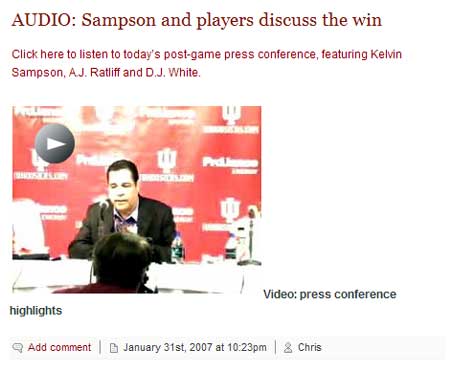I’ve been intrigued (anxious?) by Google’s plans for taking AdSense to radio but can’t seem to find out much about it. A Technorati search this morning took me to the Google Operating System blog (pretty sure it’s not connected to Google), and a post featuring excerpts from Google’s Q2 2006 earnings conference call, during which Google CEO Eric Schmidt said this about AdSense for radio:
“We are in the process of introducing AdSense for radio, which is essentially the integration of the dMarc Console and management tools into our advertising network. The dMarc team itself is fully integrated. We’re expanding it both in engineering and sales. We’re also doing it worldwide, not just in the U.S. There’s a number of very, very interesting deals being negotiated. They’re on an integration schedule of about three months from now, so every week there are more milestones, and they’re working very hard.”
From that post I jumped to an earlier one:
“Schmidt thinks that “when he is listening to the radio in his car, radio ads should personally address him about his needs. For example, while driving past a clothing store, a radio ad should remind Eric that he needs a pair of pants and instruct him to turn left at the upcoming clothing store.”
The GPS system should help radios deliver targeted ads based on information about the person. Google Maps could provide details about local businesses, the ads would be audio AdSense ads, while the information about user’s needs could be obtained from the searches or from his ToDo lists (a gadget for Google Desktop and Personalized Homepage).
dMarc Broadasting, recently acquired by Google, “connects advertisers and agencies directly to radio stations with a robust advertising platform that automates everything from sales to scheduling, delivery and report”. So this company is the first brick in the development of a new breed of radio advertising.”
Here’s what the dMarc website promises advertisers:
“dMarc Media Networks brings unprecedented immediacy to radio buys. Imagine the difference. In minutes instead of days or weeks, you can now build your own custom networks, selecting from 100’s of stations in virtually any market, through a single, source.
* Real time reports generated without human intervention
* Buy individual or multiple stations in one market or many
* Buy only those stations you really want
* Monitor feedback in real time
* Be notified instantly when ads play
* Upload spots anytime, in seconds, 24/7
I have no idea if dMarc can do all of that. Or, if radio station would want them to be able to do all of that. But I’m damned sure these are the things advertisers want and –increasingly– are insisting on.
The big question would seem to be, what’s the incentive for radio stations to participate in such a “network?” Station owners must be convinced they can make more money (or more profit) with Google AdSense than they can make on their own. IF …and it’s a big if… Google could find a way to sell EVERY ONE OF MY AVAILS…EVERY DAY… at a rate that didn’t jam me up with my local sales effort… then I might try it.
I confess it’s difficult for me to imagine that. But if Google (and others) can condition advertisers to expect measurable results and accountability — and that seems to be happening — who knows. Newspapers probably could not imagine a time when some oneline service could take away their classified ad revenue.
And during the 17 years I called on radio station managers, the #1 problem (at least in the small and medium markets) was finding good sales people. Owners have automated everything else at the radio station, why not sales?
Can any of you radio guys out there educate me on the dMarc thing?
Update: I received this explanation from a small market PD here in Missouri. Name and some particulars withheld by request.
“We operate Scott Studio’s for on-air. All hard drive audio music, liners, jingles, and commercials…with touch-screen operator computers. dMarc bought Scott Studios, and the primary commercial scheduling software Scott recommended for their system. Then Google bought dMarc.
We build our logs with our local commercials, then they can fill unused avails with their commercials. They fill the avails and upload spots all from their end, we never touch them….other than play them. I believe we have some controll over what hours they can fill, I know they don’t fill in 7a, 8a, 9a, 4p or 5p. They are :60’s and for refinancing, insurance, music collections (surfin USA the best of the beach, and stuff). Right now the clients aren’t any major chains or local businesses.
At the end of the month they send us a check for what they have run. How much I’m not sure per spots but I’ve been told the monthly check is around $X,000.
They run a lot of them in the evenings when we don’t usually have a lot of commercials scheduled. We carry Royals baseball. The 4 hour broadcast has 20 minutes available, they will fill several minutes of that and we get paid. When logs are lighter there are more in midday and afternoon.
The commercial content is not terribly exciting, it’s more spots, but it’s income that comes from unsold inventory mostly in evenings. Not a lot different than the ad’s that used to run where you are paid if someone calls and 800 number and buys Hooked on Phonics or something. I know I should probably understand this better as PD but this comes from a small station where the owner is here and does mornings/logs, etc.”
No, I think you understand (and explain) it just fine. Easy for the station. Easy for the advertiser. And I suspect the Google influence has yet to kick in. Classic Long Tail example. And I’m betting there are thousands of advertisers that will buy this time (if it’s easy enough and the price is right) without ever treading on local sales. If there’s a loser in this equation, I fear it might be programming vendors that operate on a barter basis.
 It was brought to my attention today that a couple of Indianapolis newspapers –The Herald-Times and The Indianapolis Star– were blogging about the Hoosiers. Hoosiers Insider and the Hoosier Scoop are pretty typical for newspaper blogs.
It was brought to my attention today that a couple of Indianapolis newspapers –The Herald-Times and The Indianapolis Star– were blogging about the Hoosiers. Hoosiers Insider and the Hoosier Scoop are pretty typical for newspaper blogs.

 That’s one of the headlines in the latest issue of the StateNets newsletter. StateNets –formerly the National Association of State Radio Networks — is the marketing arm for most of the state radio networks in the country.
That’s one of the headlines in the latest issue of the StateNets newsletter. StateNets –formerly the National Association of State Radio Networks — is the marketing arm for most of the state radio networks in the country.